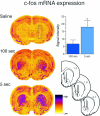The rate of intravenous cocaine administration alters c-fos mRNA expression and the temporal dynamics of dopamine, but not glutamate, overflow in the striatum
- PMID: 18396266
- PMCID: PMC2430427
- DOI: 10.1016/j.brainres.2008.02.081
The rate of intravenous cocaine administration alters c-fos mRNA expression and the temporal dynamics of dopamine, but not glutamate, overflow in the striatum
Abstract
The rapid entry of drugs into the brain is thought to increase the propensity for addiction. The mechanisms that underlie this effect are not known, but variation in the rate of intravenous cocaine delivery does influence its ability to induce immediate early gene expression (IEG) in the striatum, and to produce psychomotor sensitization. Both IEG induction and psychomotor sensitization are dependent upon dopamine and glutamate neurotransmission within the striatum. We hypothesized, therefore, that varying the rate of intravenous cocaine delivery might influence dopamine and/or glutamate overflow in the striatum. To test this we used microdialysis coupled to on-line capillary electrophoresis and laser-induced fluorescence, which allows for very rapid sampling, to compare the effects of a rapid (5 s) versus a slow (100 s) intravenous cocaine infusion on extracellular dopamine and glutamate levels in the striatum of freely moving rats. An acute injection of cocaine had no effect on extracellular glutamate, at either rate tested. In contrast, although peak levels of dopamine were unaffected by infusion rate, dopamine levels increased more rapidly when cocaine was administered over 5 versus 100 s. Moreover, c-fos mRNA expression in the region of the striatum sampled was greater when cocaine was administered rapidly than when given slowly. These data suggest that small differences in the temporal dynamics of dopamine neurotransmission may have a large effect on the subsequent induction of intracellular signalling cascades that lead to immediate early gene expression, and in this way influence the ability of cocaine to produce long-lasting changes in brain and behavior.
Figures




References
-
- Berretta S, Robertson HA, Graybiel AM. Dopamine and glutamate agonists stimulate neuron-specific expression of Fos-like protein in the striatum. J Neurophysiol. 1992;68:767–777. - PubMed
-
- Bowser MT, Kennedy RT. In vivo monitoring of amine neurotransmitters using microdialysis with on-line capillary electrophoresis. Electrophoresis. 2001;22:3668–3676. - PubMed
-
- Fosnaugh JS, Bhat RV, Yamagata K, Worley PF, Baraban JM. Activation of arc, a putative “effector” immediate early gene, by cocaine in rat brain. J Neurochem. 1995;64:2377–2380. - PubMed
-
- Greenstein YJ, Pavlides C, Winson J. Long-term potentiation in the dentate gyrus is preferentially induced at theta rhythm periodicity. Brain Res. 1988;438:331–334. - PubMed
-
- Hyman SE, Malenka RC. Addiction and the brain: the neurobiology of compulsion and its persistence. Nat Rev Neurosci. 2001;2:605. - PubMed
Publication types
MeSH terms
Substances
Grants and funding
LinkOut - more resources
Full Text Sources
Medical

